
The Dilwara Temples or Delvada Temples are a group of Śvētāmbara Jain temples located about 2+1⁄2 kilometres from the Mount Abu settlement in Sirohi District, Rajasthan's only hill station. The earliest were built by Bhima I and supposedly designed or at least financed by Vastupala, Jain minister of Dholka. They date between the 11th and 16th centuries, forming some of the most famous monuments in the style of Māru-Gurjara architecture, famous for their use of a very pure white marble and intricate marble carvings. They are managed by Seth Shri Kalyanji Anandji Pedhi, Sirohi and are a pilgrimage place for Jains, and a significant general tourist attraction. The Dilwara temples are regarded as the most impressive among Jain temples in Rajasthan.
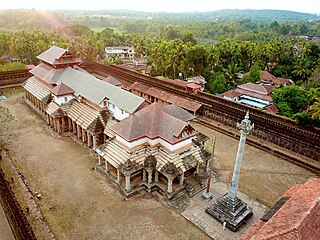
Saavira Kambada Temple or Tribhuvana Tilaka Cūḍāmaṇi), is a basadi or Jain temple noted for its 1000 pillars in Moodabidri, Karnataka, India. The temple is also known as "Chandranatha Temple" since it honours the tirthankara Chandraprabha, whose eight-foot idol is worshipped in the shrine.

The Dashavatara Temple is an early 6th century Vishnu Hindu temple located at Deogarh, Uttar Pradesh which is 125 kilometers from Jhansi, in the Betwa River valley in northern-central India. It has a simple, one cell square plan and is one of the earliest Hindu stone temples still surviving today. Built in the Gupta Period, the Dashavatara Temple at Deogarh shows the ornate Gupta style architecture.

Deogarh is a village in Lalitpur district of the Indian state of Uttar Pradesh. It is located on the right bank of Betwa River and to the west of Lalitpur hills. It is known for Gupta monuments and for many ancient monuments of Jain origins inside and outside the walls of the fort.

Tirumalai (lit. "the holy mountain"; also later Arhasugiri, lit. "the excellent mountain of the Arha[t]"; Tamil Engunavirai-Tirumalai, lit. "the holy mountain of the Arhar" is a Jain temple and cave complex dating from at least the 9th century CE that is located northwest of Polur in Tamil Nadu, southeast India. The complex includes 3 Jain caves, 2 Jain temples and a 16.25-foot-high sculpture of Tirthankara Neminatha thought to date from the 12th century CE that is the tallest Jain image in Tamil Nadu. Arahanthgiri Jain Math is also present near Tirumalai complex.

Uttar Pradesh, a state in north India has a long association with Jainism. Today the state is home to a number of Jain monuments, such as Jain Temples and Jain Tirths. There are around 213,267 Jains in Uttar Pradesh according to 2011 Census of India.

Ranakpur Jain temple or Chaturmukha Dharana Vihara is a Śvētāmbara Jain temple at Ranakpur dedicated to Tirthankara Rishabhanatha. The temple is located in a village of Ranakpur near Sadri town in the Pali district of Rajasthan.

Chandraprabha or Chandranatha is the eighth Tirthankara of Tīrthaṅkara of Jainism in the present age. According to traditional accounts, he was born to King Mahasena and Queen Lakshmana Devi at Chandrapuri to the Ikshvaku dynasty. According to Jain texts, his birth-date was the twelfth day of the Posh Krishna month of the Indian calendar. He is said to have become a siddha, a liberated soul which has destroyed all of its karma.
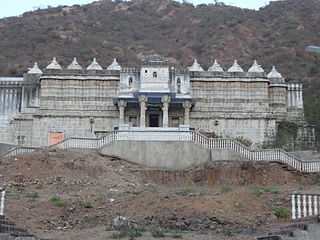
Mirpur Jain Temple is situated in Mirpur, a fortified village in the Sirohi district of Rajasthan, India. The village has four Jain temples.
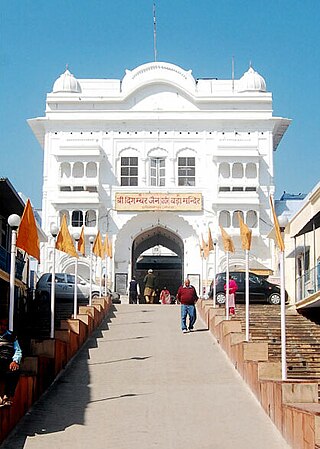
Shri Digamber Jain Prachin Bada Mandir is a Jain temple complex located in Hastinapur, Uttar Pradesh. It is the oldest Jain temple in Hastinapur dedicated to Shri Shantinatha, the 16th Jain Tirthankara.
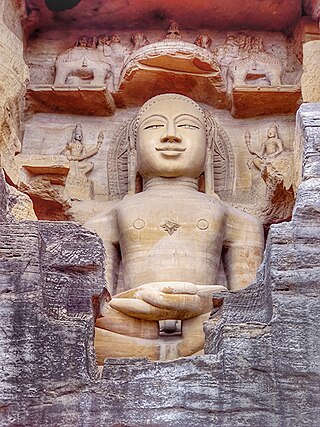
The Gopachal rock-cut Jain monuments, also called Gopachal Parvat Jaina monuments, are a group of Jain rock-cut carvings dated to between the 7th and 15th centuries. They are located around the walls of the Gwalior Fort, Madhya Pradesh. They depict Tirthankaras in seated Padmasana posture as well as standing Kayotsarga posture, in the typical naked form of Jain iconography.

Jain Basadi complex in Halebidu, Hassan district consists of three Jain Basadis dedicated to the Jain Tirthankars Parshvanatha, Shantinatha and Adinatha. The complex is situated near Kedareshwara temple and Dwarasamudra lake. The temple complex also includes a step well called Hulikere Kalyani.
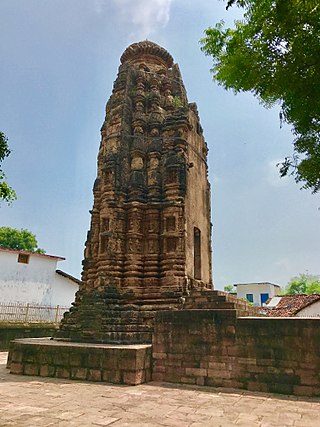
Arang Jain temples is group of three Jain temples in Arang, Raipur, Chhattisgarh, India. These temples dates back to the 9th and 11th centuries.

Siddhachal Caves are Jain cave monuments and statues carved into the rock face inside the Urvashi valley of the Gwalior Fort in northern Madhya Pradesh, India. There are the most visited among the five groups of Jain rock carvings on the Gwalior Fort hill. They were built over time starting in the 7th-century, but most are dated to the 15th-century CE. Many of the statues were defaced and destroyed under the orders of the Muslim Emperor Babur of the Mughal dynasty in the 16th century, while a few repaired and restored after the fall of the Mughal dynasty and through the late 19th century.
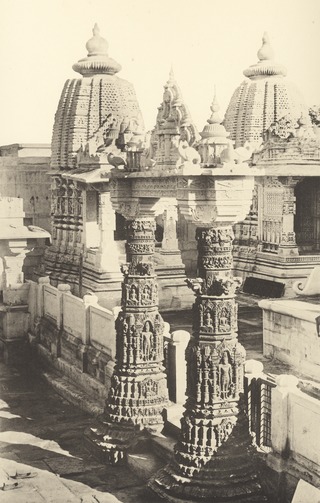
The Mahavira Jain temple is built in Osian of Jodhpur District, Rajasthan. The temple is an important pilgrimage of the Oswal Jain community. This temple is the oldest surviving Jain temple in Western India and was built during the reign of Mahārāja Śrī Vatsarāja of Imperial Pratihāras. The temple is visited by both Jain and Hindu.

Vidisha is considered to be Puranakshetras Jain tirtha. The Jain temples are located in Vidisha district in state of Madhya Pradesh, India. According to Jain belief, Vidisha is the birthplace of Shitalanatha, the tenth tirthankar. Here the first 108 feet elevated temple with all Tirthankaras with Shitalanatha as the principal deity is under construction.

Maladevi Temple is a Jain temple located in Gyaraspur town of Vidisha in state of Madhya Pradesh, India.

Bajramath Temple is a Jain temple located in Gyaraspur town of Vidisha in state of Madhya Pradesh, India.
Panchasara Parshwanath temple is a Jain temple located in Patan, Gujarat. The temple was constructed in 8th century during the reign of Vanaraja Chavda of Chavda dynasty.

The Kumbharia Jain temples is a group of five Jain temples in the Kumbhariya, Banaskantha district in Gujarat, India. Constructed from 1062 to 1231 CE during the reign of the Chaulukya dynasty, they are noted for their elaborate architecture.

























